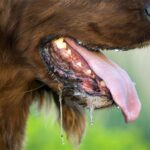How To Stop A Dog From Nipping When Excited
How to Stop a Dog from Nipping When Excited: Tips and Tricks for Training Your Pup
Dogs can be wonderful companions, but they can also exhibit some unwanted behavior when they get too excited. One common problem is nipping, which can be painful and even dangerous if not addressed properly. Whether you have a puppy or an adult dog, it’s never too late to teach them how to control their biting urge. In this article, we’ll share some effective methods for stopping your dog from nipping when excited.
Understanding Why Dogs Nip
Before we dive into the training techniques, let’s first explore why dogs nip in the first place. There are several reasons why your dog may resort to biting or mouthing when they’re feeling playful, anxious, or overstimulated:
– Teething: Puppies go through a phase where their baby teeth fall out and their adult teeth grow in, which can cause discomfort and itchiness in their gums. Chewing on objects or people can relieve the pain temporarily.
– Playfulness: Dogs use their mouths to play with each other and with humans, especially during socialization periods. However, what may be gentle nibbling for another dog may hurt a human skin or clothing.
– Anxiety: Some dogs may nip as a stress response to unfamiliar situations or people, or as a way of seeking attention or reassurance from their owner.
– Overstimulation: Dogs that get too excited by loud noises, fast movements, or intense play may lose control of their biting inhibition and start to nip or snap at whatever catches their attention.
Now that you know some of the reasons behind nipping behavior, let’s move on to the solutions.
Training Techniques for Stopping Nipping
1. Redirecting with toys
One of the easiest ways to discourage your dog from nipping at you is to provide them with an alternative target for their mouth. Whenever you see your dog gearing up to nip you or someone else, offer them a toy or chew bone to bite instead. You can also use a tug rope or a ball to play fetch with them, but make sure they learn to release the toy on command without biting your hand in the process.
To make the toy more appealing, you can smear some peanut butter or liver paste on it, or freeze it overnight for a refreshing treat. By rewarding your dog for chewing on appropriate objects, you’re teaching them what behavior is acceptable and what isn’t.
2. Teaching “no” and “off”
Another way to deter nipping is to teach your dog some basic obedience commands that signal when they’re doing something wrong. Saying “no” in a firm but calm tone can interrupt your dog’s train of thought and make them pause before biting again. However, be careful not to overuse the word “no” or shout it out too loudly, as this can scare or confuse your dog.
Similarly, teaching your dog to jump down from furniture or people on command (e.g., “off”) can prevent them from getting too close to sensitive body parts such as faces, hands, or feet. You can lure your dog off with a treat or pat the ground with an open hand to encourage them to step down gently.
3. Socializing with other dogs
If your dog tends to nip at strangers or other animals out of fear or aggression, socialization may be the key to reducing their anxiety and reactivity. Exposing your dog to friendly and well-behaved dogs under controlled circumstances (such as a dog park or a pet store) can help them learn how to communicate and behave appropriately around others.
However, don’t force your dog into situations where they feel uncomfortable or overwhelmed. Start with short sessions and gradually increase the duration and complexity of the interactions as your dog gains confidence and trust. Always supervise your dog’s interactions and intervene if they start to exhibit nipping or other aggressive behaviors.
4. Using positive reinforcement
Finally, one of the most effective ways to train your dog to stop nipping is to reward them for good behavior instead of punishing them for bad behavior. Positive reinforcement involves giving your dog treats, praise, and affection when they do something you want them to do, such as sitting calmly or playing gently.
You can also use a clicker or a verbal marker (e.g., “yes”) to signal the exact moment when your dog exhibits the desired behavior, and then follow up with a treat or a play session. This technique helps your dog associate the action with the consequence in a clear and consistent way, without resorting to physical or verbal aggression.
Conclusion
Stopping a dog from nipping when excited requires patience, consistency, and creativity. By understanding why dogs nip and using positive training methods, you can help your pup develop better bite inhibition and social skills. Remember that every dog is different, so what works for one may not work for another. Be willing to adapt and experiment until you find the best approach for your furry friend. With time and effort, you can turn nipping into licking!



